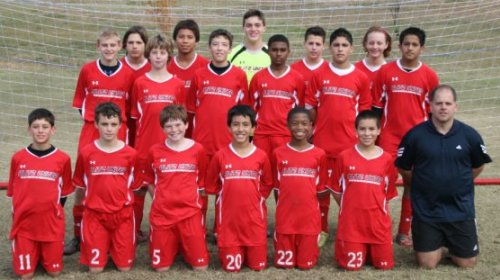
The best and fastest way to learn a sport is to watch and imitate a champion.
Jean-Claude Kelly
Forwards and midfielders play a critical role in a high-pressure defense and can win the possession back quickly if they attack in an organized manner.
This discussion assumes that the team is playing a 4-4-2 system. I consider it to be the most commonly used formation, and there is not much of a difference between this formation and others like 3-5-2.
If the keeper has the ball for the opposing team and throws it out to his or her right marking back, the defending forward closest to the ball should make a run toward it that is bent from the middle out. By approaching the ball at this angle, the opponent is forced to take the ball down the line, which is the intended result. The first defender.s main function is to make sure the ball does not get played back to the keeper or anyone who can switch it around the back. The second forward.s primary responsibility is to go back and towards the middle to help clog up the middle.
The opponent with the ball will approach the sideline, thinking that the defending forward has been beaten, The attacker may not realize that he or she is doing exactly what the defending team wants, creating a situation that allows the outside midfielder to step up and double team the ball.
The key here is that the outside midfielder can't step up until coverage behind is provided by either the marking back or a center midfielder. When this coverage is in place and communicated, the outside mid steps into the double team while the covering player steps to the attacking outside midfielder. At this point, the player with the ball is neatly boxed in, with the outside midfielder blocking forward progress and lateral options eliminated by the near-side defensive forward and the touchline. The only two good offensive options are to try to split the approaching defenders by passing into the middle of the field or to kick the ball aimlessly downfield. To prevent a splitting pass, the inside midfielders and stopper, along with the second forward who came toward the middle and back, must mark the nearest opponents to remove any middle-field options. Any attempted splitting pass should be negated this way. This leaves the aimless long ball as the only viable outlet for the player with the ball.
While all of this shifting is taking place, the backs must step up, which allows them to compress the field and win any errant passes. By stepping up (it's extremely important for the keeper to step up as well in order to handle balls played over the defenders. heads), all balls should be won. At the very least, the tactic forces the the attacking players to be running in the wrong way, away from their goal, in order to stay in an onside position. The outside midfielder on the opposite team should be back and toward the middle since there is no way for him or her mark to receive this ball. This outside midfielder actually becomes a second sweeper. If the ball-side marking back is the one to step up to the outside midfielder.s mark, the sweeper will have stepped over to cover his or her mark, making it vital that the outside midfielder from the opposite side of the field drops back and offers defensive support.
If the opponent with the ball is able to play the ball back to her keeper, both forwards must get back and to the middle. Chasing the ball in this situation is ineffective and leaves the team exposed, unless there is an errant pass back.
When the forwards make their bending runs, they must do so at full speed. Being under control during the run is important, because mistiming it can cause tremendous chaos for teammates. However, if the opponent has received the ball with his or her back to the field, the forward and outside midfielder have an opportunity to pressure the ball with an aggressive run, since the chances are slim that the possessing player will have time to turn, find an open player and successfully move the ball out of pressure. Know when to take chances and when to play safe.
There are two keys to high-pressuring in the offensive third of the field. The first is to practice it a great deal. Even more important is good communication. If one player steps up and teammates aren't prepared for the maneuver, disaster will strike. With patience and good communication, this is an extremely effective way of making the quick transition from defense to offense.
Editor's Note: Lawrence Fine produces FineSoccer.com, an online resource for a variety of tips, ideas and newsletters related to soccer coaching. A member of the NSCAA Website Development Committee, Fine also serves as volunteer assistant coach for an NCAA Division I men's team.